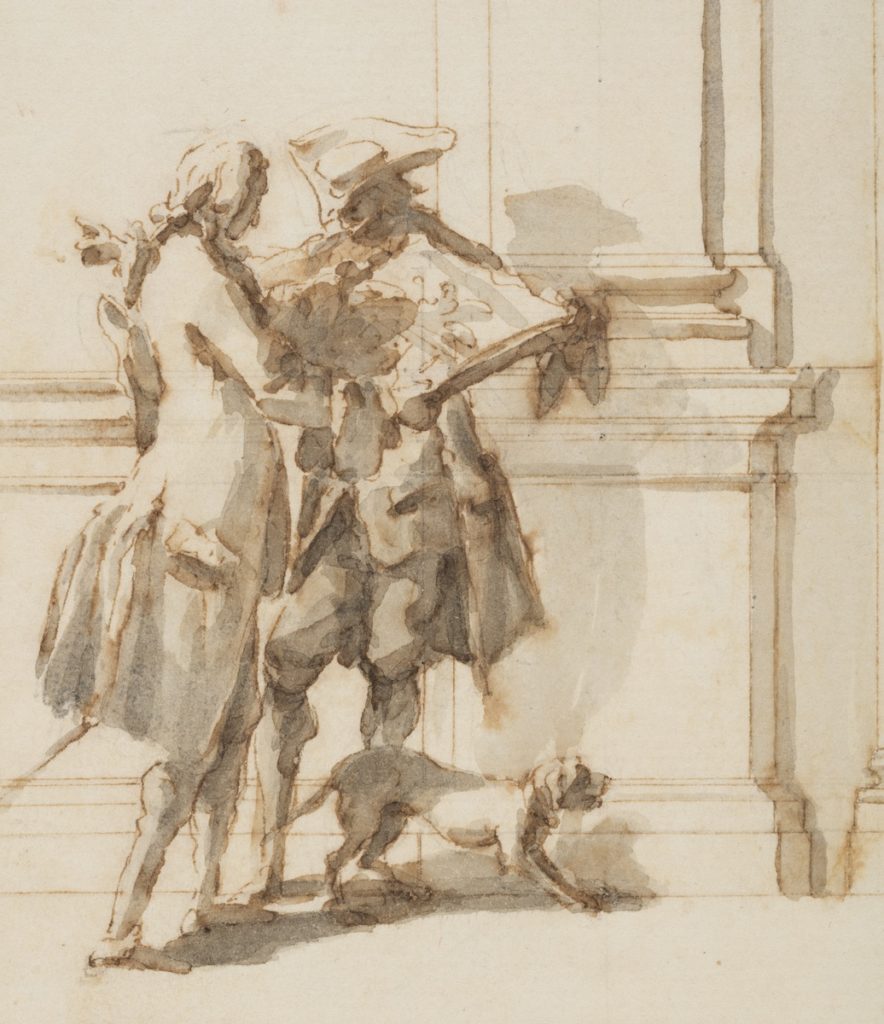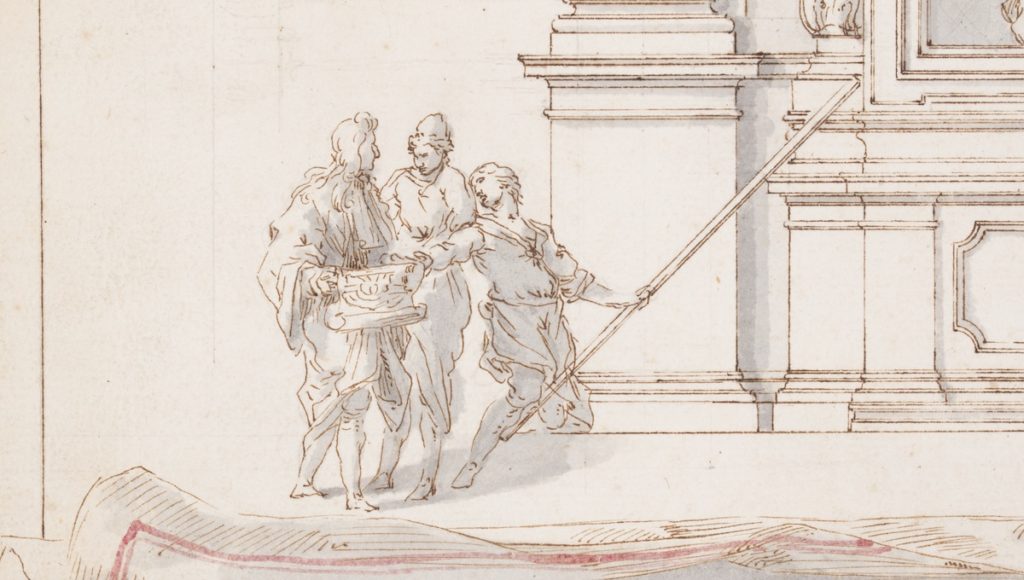Tracy Ehrlich
Born and raised in the artists’ quarter in Rome that stretched from the Piazza del Popolo to the Piazza di Spagna, Carlo Marchionni (1702-1786) was a student of the architect Filippo Barigioni. He won a first prize in architecture in the 1728 Concorso Clementino, and a first prize in sculpture in 1732. Recognized in his own time as a consummate draftsman, Marchionni was a practitioner in multiple spheres. He was not only an accomplished sculptor and a distinguished architect, but also a designer of festival decorations, theatrical scenery, furnishings, wall decorations, tableware, and visiting cards, and a caricaturist as well. He was employed as a hydraulic engineer to the papacy throughout much of his career. A protégé of Cardinal Alessandro Albani, Marchionni came to prominence as an architect in the 1730s. Making the most of his connections at the highest rungs of the Roman social ladder, Marchionni accumulated a substantial book and art collection; he maintained a well-heeled household; and he was elected to the most prestigious and influential academies of his day. Introduced to the Fabbrica of St. Peter’s by Barigioni and endorsed by the Albani family, Marchionni rose to the top of the hierarchy of papal architects and left an indelible mark in Rome in the form of the Villa Albani on the Via Salaria and the New Sacristy of St. Peter’s at the Vatican.[1]
Marchionni was a designer of all sorts of things; but, most of all, he was a designer and creator of works on paper. His preferred graphic medium was drawing. In contrast to his forebears, such as the architect Carlo Fontana (1638-1714), or his contemporary and sometime rival Giovanni Battista Piranesi (1720-1778), Marchionni evidenced no desire to engage in large-scale print and book production.[2] His corpus of built works is small and relatively conservative in style, whereas almost a thousand drawings from his hand survive—including figural studies, landscape drawings, designs for catafalques and stage scenery, and architectural renderings—distinctive for being highly inventive and imaginative in nature.[3] His extant work suggests he identified more closely with drawing, particularly the spatial realm of architectural draftsmanship, than any other artistic sphere. Marchionni expressed the virtuosity of his graphic talent best in materials that supported his affinity for painterly handling and the rendering of pictorial imagery. He employed pen and ink, as well as brush and ink wash (or sometimes watercolor), to invest architectural renderings with forms of visual and somatic experience hitherto little explored in this field. Throughout his work he proclaimed the power of drawing—and, by implication, the artist—to cross spatial as well as social and artistic boundaries, challenging academic rules around artistic production, conventions of genre and architectural representation, and norms of self-portraiture. For Marchionni, architectural drawing was the quintessential expression of artistic self-hood.
Trained in the studio of Barigioni, Marchionni knew all too well the rules of academic drawing. Long before his time, learning to draw was already considered the essential foundation of the artist, whether painter, sculptor, or architect. In 1550 Giorgio Vasari, the Tuscan painter, architect, and historian, called disegno the “father of our three arts.”[4] The word disegno implied both the physical act of drawing and the intellectual process of design.[5] Disegno referred to an object as well as to a creative act. Over the course of the next two centuries, both the rules for drawing and the rules for training artists through drawing were codified. Art academies were established throughout the Italian peninsula. Marchionni was thoroughly schooled in the repertoire of drawings customarily employed by eighteenth-century architects—including the elevation, plan, section, and detail—and in the techniques of orthogonal projection associated with them. Marchionni nonetheless evidenced a lasting commitment to stretching the rules, even as he practiced within and eventually presided over the Academy of St. Luke, where he taught and by 1775 rose by to the position of principe (prince or head of the Academy).[6]
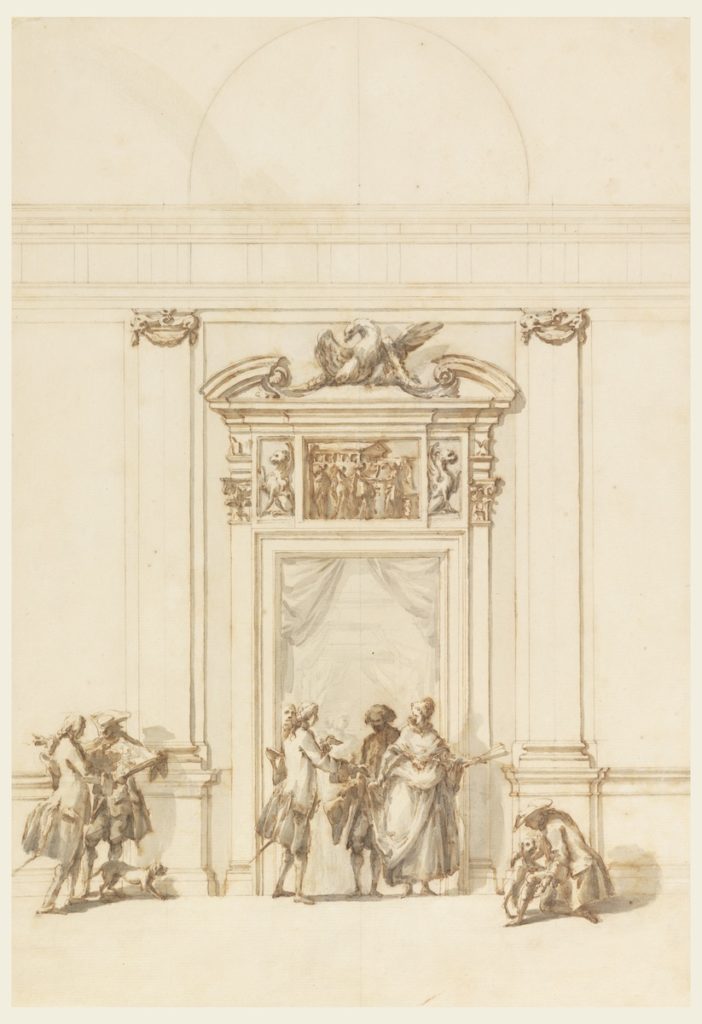
Marchionni incorporated human figures into a vast array of drawings for domestic, sacred, and festival buildings in a way that was virtually unparalleled in the European design tradition (Figs. 1, 3, 16). In the history of architectural drawing up to 1800, figures appear often in urban, architectural, or landscape vedute (perspectival views), but rarely do they appear in elevations. When they do, they are employed for scale, as for example in the work of Baldassare Peruzzi (1481-1536) or that of Giuseppe Barberi, one of Marchionni’s younger Roman contemporaries.[7] In contrast, Marchionni turned his attention to the social role of the body, including his own role in the human and spatial relationships he envisioned. The architect’s material presence is notable within drawings that visualized social conduct and dynamics. Marchionni included himself often in his architectural renderings, from elevations for domestic interiors to sections and details for technical surveys. He positioned himself with drawings in hand or tucked beneath a finely clothed arm, absorbed in conversation with patrons, peers, and craftsmen alike (Figs. 1-4). By the early eighteenth century, self-referential imagery in the fine arts was a long-standing tradition. The internal drawings signal Marchionni’s presence and refer to artistic production, a type of self-portrayal deeply rooted in the history of European figurative art.[8] Nonetheless, the appearance of corporeal forms in architectural elevations, let alone the inclusion of the figure of the architect, was unprecedented. Marchionni’s renderings brought audiences accustomed to the standard academic draftsmanship of the day into a direct encounter with the body in space. Most striking, perhaps, is the way Marchionni’s figures perform conversations around drawings. His eloquent bodies offer a commentary on sociability and the practice of architecture and claim special status for architectural representation as an active agent in the formation of culture. They suggest a link between conversation and creativity, specifically in the art of drawing.
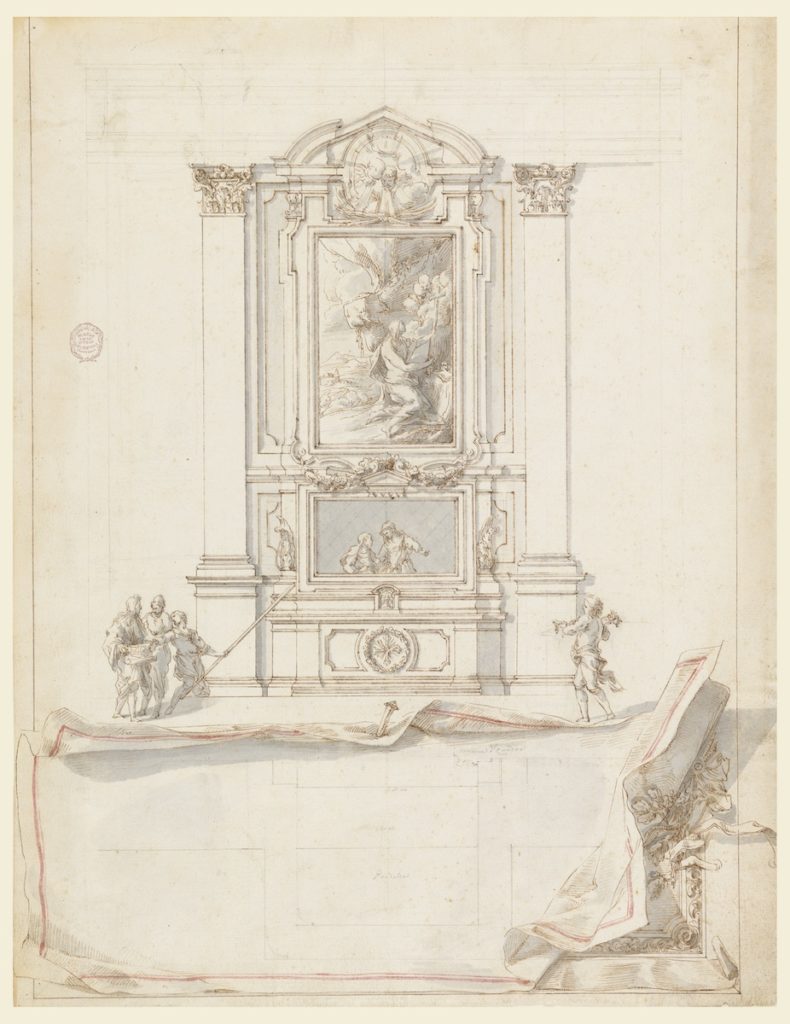
In addition to the type of small drawing that the genteel designer frequently displays, a second kind of internal drawing, which is more substantial in scale, unfurls across many of Marchionni’s architectural renderings (Figs. 3, 11, 12). The fictive drawing asserts itself as an object with energy of its own, one that traverses spatial boundaries and brims with creative energy. In Marchionni’s hands the materiality of the drawing—the very paper itself—is invoked in a visual discourse of creativity and artistic agency. Marchionni produced drawings that were not simply structural solutions and design proposals but also cultural agents, whose imagery and materials were deployed in a way that was generative, experiential, and transformative for viewers. Though Marchionni often autographed his presentation drawings with the meticulous, rectilinear signature of a trained architect—Carlo Marchionni Architetto Romano—equally often he encoded his presence in exceptional ways. He inscribed himself both literally and figuratively in profoundly inventive spatial renderings whose corporeal forms, whether they were living flesh or mobile drawings, orchestrate the experience of the audience. Marchionni’s renderings point to a sense of self deeply embedded in the materiality and agency of drawing.
Materials, Materiality, and Experiential Drawing
In 1728 Marchionni made his debut as a Roman architect, winning a first prize in architecture in the Concorso Clementino, a competition staged at the Academy of St. Luke that culminated in an award ceremony graced by the pope’s presence. The subject set for architectural contestants in 1728 comprised a piazza set by a harbor, for which Marchionni produced seven drawings in pen and watercolor.[9] Marchionni matured in a period when the rules of architectural drawing were in transition, when architects such as Filippo Juvarra (1678-1736), who won the Concorso in 1705, were bringing color and heightened illusionism into play. Juvarra displayed his superior control of the draftsman’s tools in both his winning design of 1705 and his presentation drawing of 1707, which he donated to the Academy of St. Luke to mark his admittance to the membership, as was customary. Such drawings were vital instructional materials for young students of architecture in Rome like Marchionni. In each case Juvarra masterfully represents the ground plan as if it were a separate sheet superimposed on the elevation, weighted down by architect’s tools that only partially forestall curling at the edges.[10]
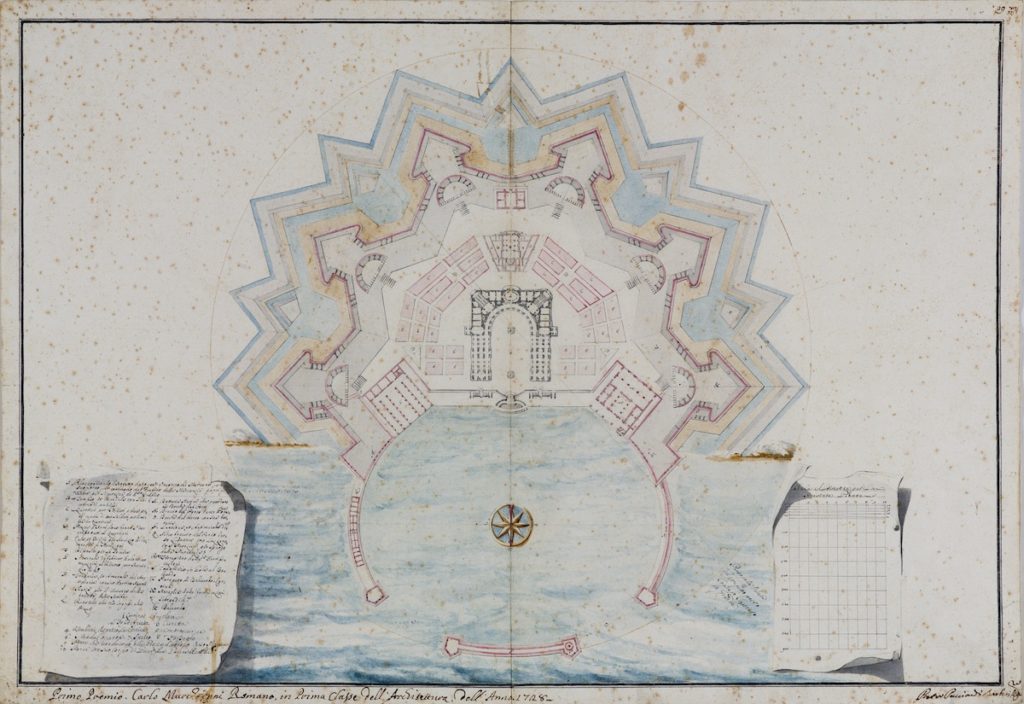
At the turn of the eighteenth century, the superimposition of illusionistic layers to the graphic surface was nothing new. Juvarra stood on the shoulders of his teacher, Carlo Fontana, who led the Academy of St. Luke in the 1690s and whose architectural drawings and prints incorporated creative manipulations of the surface in the form of illusionistic cartouches, legends penned on fictive scrolls, and trompe l’oeil maps or architectural renderings arranged in overlapping layers across the page.[11] Absorbing Fontana’s and Juvarra’s lessons in color and illusionism, Marchionni introduced fresh imaginative potency to the competition series he presented to the jury in 1728. He transformed a straightforward professional exercise assigned by the Academy into a pictorial tour de force.[12] Marchionni’s suite of architectural renderings not only exhibits his technical facility, but also his desire to stretch the boundaries of academic draftsmanship in multiple ways, in particular by questioning longstanding conventions of genre and hierarchies of artistic value (Figs. 5-10). Marchionni tacked two fictive sheets to his general plan for the harbor, reimagining the conventional legend in a way that reflected the lessons of his predecessors. His plan is suffused with an array of striking colors that articulate architectural elements while they transform a geometric exercise into a landscape scene (Fig. 5).[13] The curling corners of the superimposed sheets indicate a shifting breeze that ripples across the vivid blue water surface. Color had been used very rarely by Italian architects until Fontana’s and Juvarra’s time, and even in the later 1700s a preference for monochrome drawings prevailed. Though color appeared in the drawings of many contestants in the Concorsi Clementini, it was not employed systematically. The rules for using color to differentiate the parts of a building in plan or in elevation, which were so critical to the French academic system, were never fully adopted in Rome.[14] In Marchionni’s plan, color serves both practical and pictorial ends, enhancing graphic clarity and elevating the visual appeal of the drawing.[15]
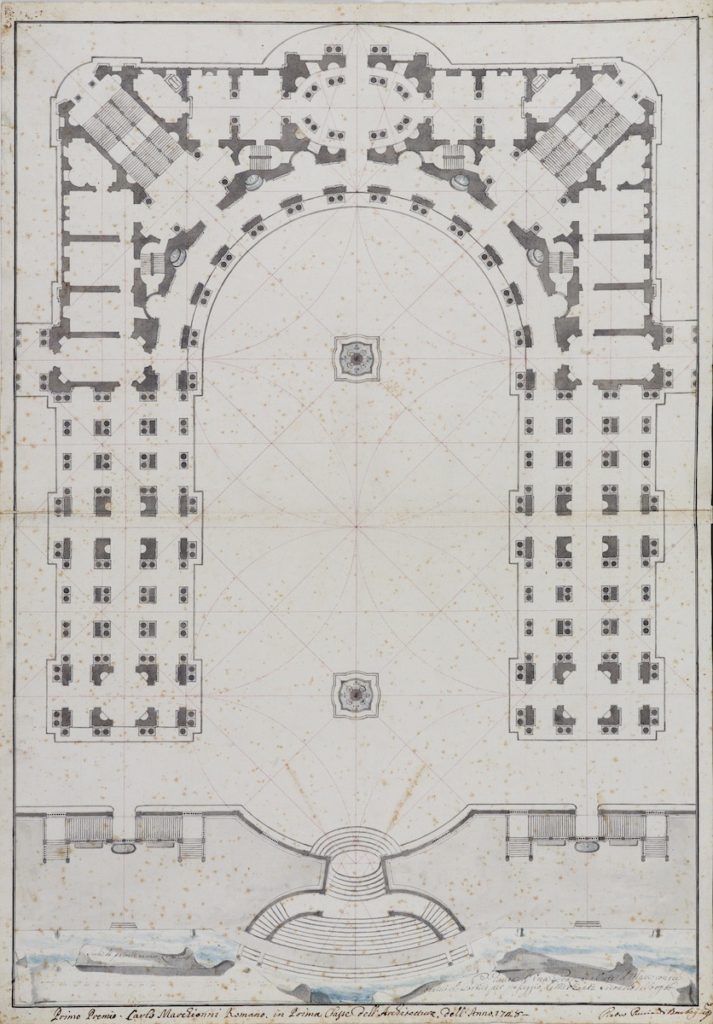
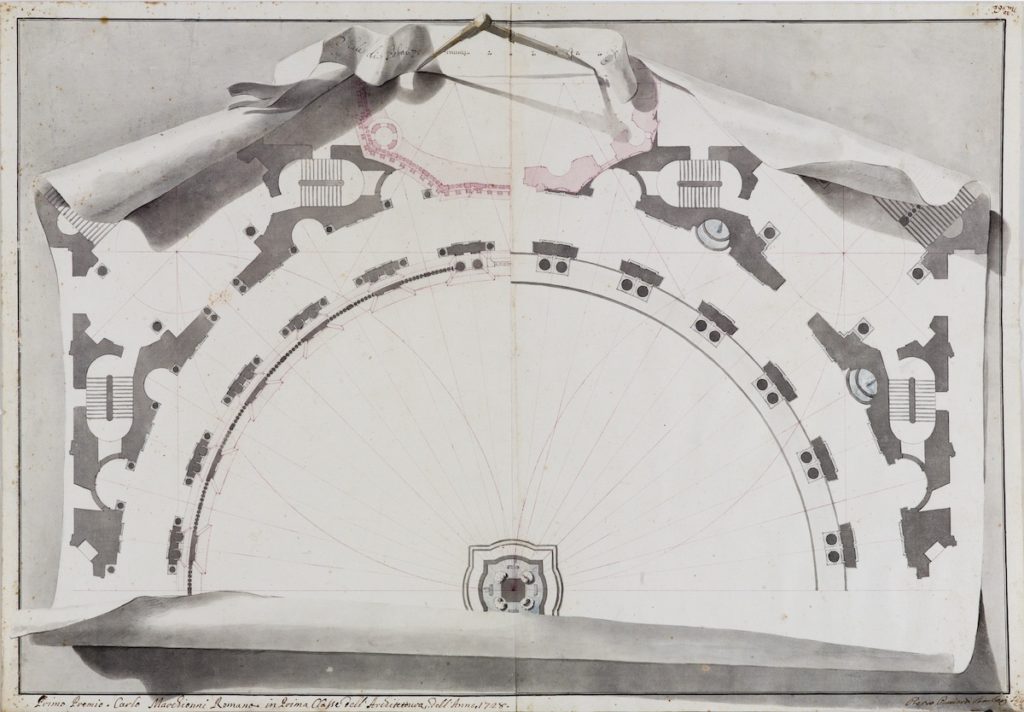
Marchionni employs color and illusionism not only to display his professional mastery and enhance aesthetic value, but also to remind viewers of the materiality of his work. His plan for the main building by the harbor appears straightforward (Fig. 6); yet, the lines of the architect’s compass are inked in pink, a distinct departure from the graphite drawings of late Baroque architects such as Francesco Borromini (1599-1677). In this plan, Marchionni transforms the geometric framework into a feature in a pictorial scheme, and he cannot resist an illusionistic flourish where the steps of the harbor lead to the sea. His detail plan for the interior court of the main building translates a simple drawing into a virtuosic display of illusionism that surpasses Juvarra in its bold intersection of fictive with real space (Fig. 7). Held in place by an open compass at the top of the page, the edges of the fictive sheet curl; the paper is crisp and feather thin, its materiality instantly apprehended by the viewer. A small flap of paper, layered across the top of the drawing and rendered in pink watercolor, offers alternate design solutions to the academic jury. Layered over the flap, a narrow scroll curls around the points of the dividers and is marked with a scale in Roman feet. The traces of the compass are inked in pink, just as they are in the general plan of the building. With this hint of color, Marchionni implies an aesthetic of the simple arc. The vivid, graphic curves evoke the swinging of the dividers, depicted above in trompe l’oeil, and call to mind the hand of the artist.[16]
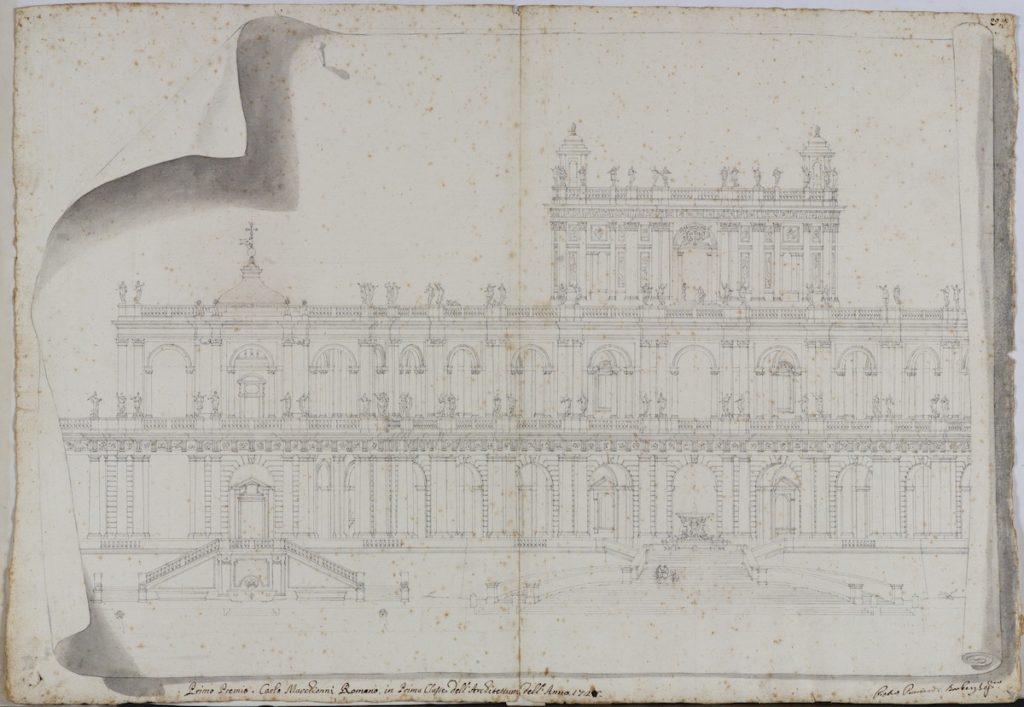
The drawings Marchionni submitted to the academic jury in 1728 exploit the dialectic of object and action inherent in the word disegno, impressing on viewers the presence of the artist as well as their own role in an experience that unfolds. Even the elevation of the main building, where Marchionni employs orthogonal projection in a traditional manner, is conceived as if it were drawn on a scroll unrolled for the viewer and tacked temporarily to the studio table (Fig. 8). The shadows of the curling paper fall dramatically across the page, underscoring the materiality of the paper as it crosses spatial boundaries. Since antiquity “display” (displicare in Latin) meant to unfold or unfurl and implied motion and performance.[17] The conceptual complexity of the term is aptly applied here, where the viewer is not merely a witness but is also an active participant. The drawing presents itself as an autonomous—even startling—object that places both visual and somatic demands on the audience.
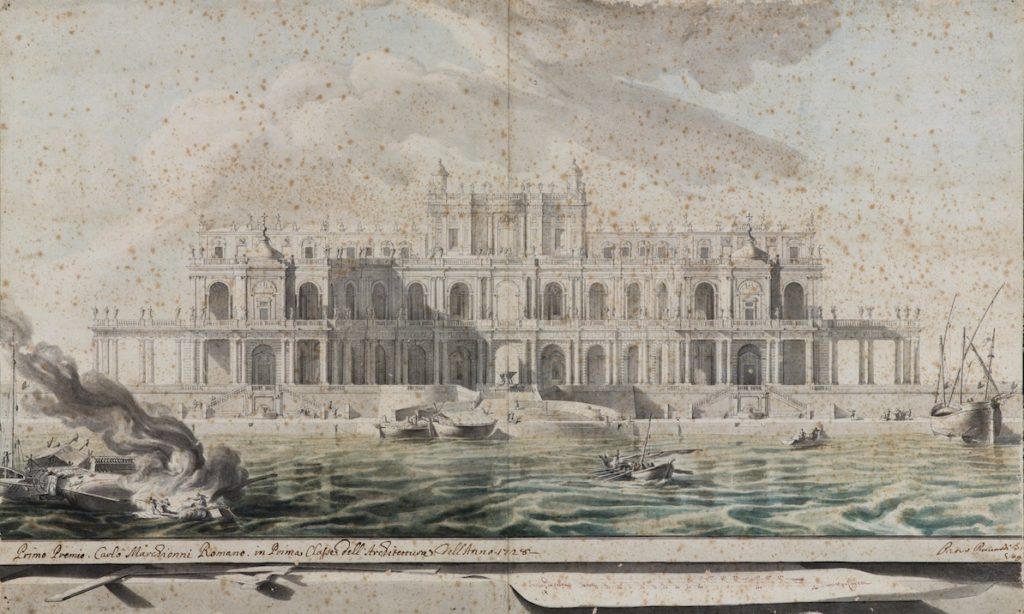
Marchionni’s suite of drawings defies conventional typologies and points to the generative power of the graphic work of art. By the eighteenth century it was common to incorporate an architectural veduta (perspective view) as a persuasive element of a presentation set. The two views Marchionni included with his 1728 competition entry assert the dynamic, performative role of drawing (Figs. 9-10). In his general view of the harbor, Marchionni reveals what would become a lifelong interest in landscape, which he pursued in a prodigious output of landscape drawings, as well as an interest in scenography, which he explored in festival and ephemeral design.[18] In this view the building emerges as a sculptural element, with its features carved in light and shadow; the structure is enveloped by a swirl of clouds and by rippling aquamarine waves that reflect a glimmer of the monumental facade. Enlivened by figural vignettes, which were common in landscape views, the tranquil scene is disrupted in the foreground by a dramatic fire that has erupted in the hull of a capsized ship. Marchionni’s pictorial approach blurs typological boundaries. The drawing slips between the genres of architectural rendering and landscape art, making it difficult to classify. Marchionni employs a range of visual means to engage the viewer in a spatial, optical, and emotional experience; however, lest the viewer become lost entirely in this imaginative world, he leaves reminders that it is undeniably a drawing—a material object—hung for display.[19] The architect’s tools and a fictive sheet are strewn on a shelf below. The trompe l’oeil effect disrupts the illusion of the picture plane.
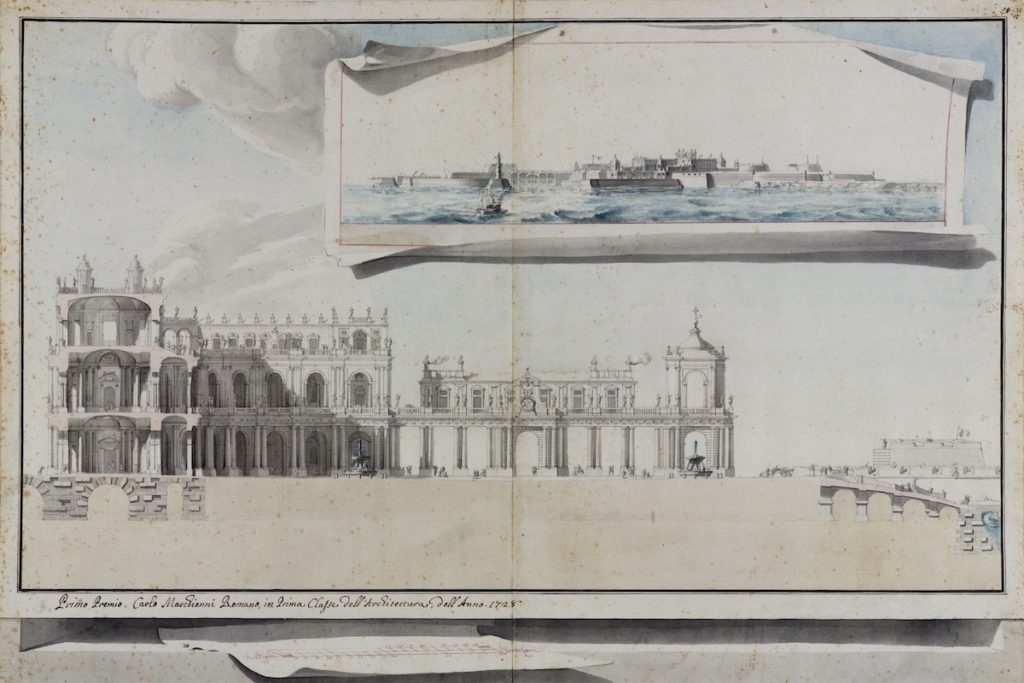
Marchionni’s section for the main building with a porticoed piazza is playful and visually compelling in much the same way as is the general view (Fig. 10). The section, although it asserts scientific rigor with its carefully delineated building foundations, is depicted as if it were tacked up on a wall, where it mostly covers a large niche. A smaller view is pinned on top, the edges of the paper curling to separate the fictive sheet from the surface. A third drawing, which depicts the scale, rests on a sill below as if set down momentarily by a juror perusing entries at the concorso (much like the trompe l’oeil in the general view (Fig. 9). In this period, drawings were displayed as models for instruction at the Academy of St. Luke, and they were shared in genteel circles of collectors and connoisseurs eager not only to discuss them but also to acquire them as a sign of wealth and taste. Marchionni’s concern for educating his students is apparent in the nine albums of architectural drawings that he kept in his studio until his death.[20] Even as a young artist, Marchionni demonstrated keen understanding of the way drawings were displayed and discussed in the Roman architectural world, whether they served as tools of instruction or marks of professional accomplishment and status. Equally important, he asserted the materiality of the drawing, an active, moving, vibrant thing designed to shape the experience of the audience.[21]
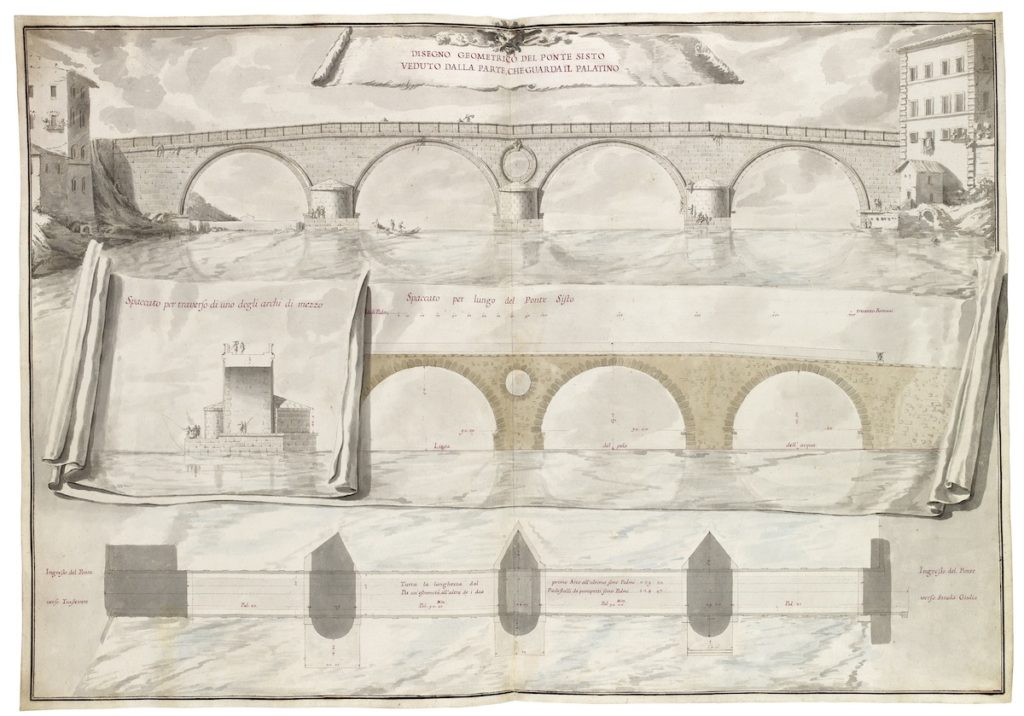
We might easily dismiss Marchionni’s 1728 prize-winning drawings as the products of youthful bravado unfettered by membership in the Academy, which was granted to the architect only twelve years later. However, the graphic work Marchionni produced over the course of his lengthy and prolific career speaks to a lifelong fondness for challenging artistic conventions. He looked for novel, imaginative ways to impress his artistic identity on the page. More often than not, he transformed technical drawings into spectacular pictorial displays. His bread and butter derived from his employment as a hydraulic engineer, which was a specialty that fell within the purview of architects at this time. In a 1735 survey of the bridges of Rome and the river Tiber, set forth in a suite of four drawings, Marchionni conveyed practical information in a way that suggests the composition of the page was as important as the empirical data (Fig. 11). He applied his considerable talent to achieving the optimal graphic expression of what twenty-first century critics refer to as “information design.”[22] In his rendering of the Ponte Sisto, for example, Marchionni offers multiple viewpoints of the bridge in a clear yet compelling fashion. Across a picturesque view of the river and its banks, Marchionni unfurls a set of illusionistic scrolls that yields significant information about the bridge. Two layers of fictive paper unspool as if they were released by the architect across his drafting table, with the longer sheet throwing shadow across the brown ink frame of the rendering underneath. The longer sheet presents a longitudinal section of the bridge that makes clear the nature of the structure and its materials. A significantly shorter scroll, which is layered on top, opens to reveal a transverse section. A handful of figures enliven the scene and offer a sense of scale. Marchionni carefully attends to the overall composition of the drawing—his principal design object—while he calls attention to the material support, that is, the paper itself. The act of unrolling, though only implied, invokes the architect’s corporeal presence and introduces a temporal element to the display. Marchionni renders the labels and measurements with a deeply saturated red ink. In making this choice he translates technical information into pictorial language. Using quick strokes of wash to express the movements of the river and the sky, along with figural vignettes, Marchionni transforms the whole into a scenic landscape.
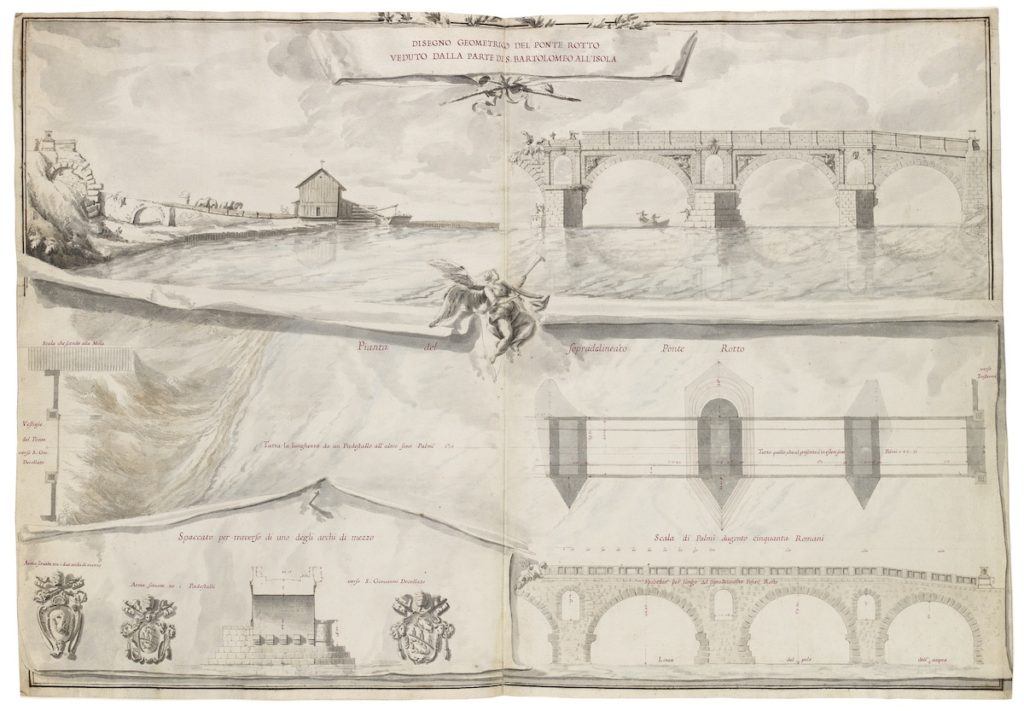
In his rendering of the Ponte Rotto (Fig. 12), Marchionni combines pictorial devices with design conventions—including a plan, section, and detail of the bridge—in much the same way as he does in the Ponte Sisto sheet. He disrupts the spatial illusion of the composition while drawing attention to his tools and materials, and to his methods and process. In this work, as in many others, Marchionni emphasizes the performative nature of disegno—an object that registers and communicates ideas, a physical action, and a method of creative invention.[23] In this way, he underlines the status of the architectural drawing as a work of art.[24] At the top of the page he arranges a picturesque river scene. Below he layers illusionistic sheets that assert their presence in the viewer’s space.[25] One sheet is pinned up for display; the slender tack worked in gray wash throws a deep shadow across the surface. Another, much larger sheet, is unfurled by the action of a flying figure of Fame wielding her trumpet. She appears to have blown in from another type of drawing altogether. Whatever her origins, her centrality to the image is unmistakable. Whether tacked to the drafting table or to the wall, the paper evokes the material world of the architectural studio. In so doing, Marchionni invents his own form of self-referential signature, encouraging the viewer to shift back and forth between the illusionistic world of landscape art and the space of the artist, which the viewer ineludibly shares. Even the most practical drawing is not only a means to an end, but also an end in itself—a work of art that is conspicuously self-reflexive. In Marchionni’s hands object and process, thing and action, are conflated. The drawing is nothing less than an experiential art form.
Drawing, Conversation, and the Corporeal Self
Marchionni inscribes his creative presence in the materiality of the drawing in a manner that is remarkable. Similarly inventive is the way he brings the body and its gestures to the fore. His original contribution to the history of disegno, specifically the history of architectural drawing, rests on his conceptualization of the social role of the body in early modern space. Most likely imported from the tradition of urban and landscape views, where miniscule figures are common, the human form is writ large in many of the architectural renderings Marchionni executed during his six-decade-long career (Figs. 1, 3, 16). Marchionni’s extensive personal art collection included the view paintings of such contemporaries as Gaspar van Wittel (1653-1736) and Giovanni Paolo Panini (1691-1736). Notwithstanding his work’s resemblance to these architectural vedute, in particular Panini’s, the drawings under discussion here are architectural elevations. Marchionni’s figures conspicuously engage in sociable acts, as do Panini’s; however, Panini deploys small-scale figures in grand, panoramic settings. Marchionni’s elevations imply an analogy between the body and the building that the vedute do not.
An eloquence of the body, in particular the art of civil conversation, marks Marchionni’s architectural drawings as unique. In his drawings, finely tuned, moving, gesturing figures enact social relations. Gestures and movements suggest discourse, but the audience must supply the words or “text.” Narrative in the conventional sense has been eliminated, much as Mary Vidal has stressed in her work on the painted conversations of Antoine Watteau.[26] Gestures encourage viewers to reflect upon human relationships and to imagine a multiplicity of possibilities, and moving bodies engage viewers in space. The body of the architect is quite often physically present with drawings in hand. His eloquent form is ready to engage in civil discourse with conversational partners of all kinds. Although self-referential imagery was common in eighteenth-century art, the insertion of the corporeal form of the architect into an elevation, detail, or technical drawing was novel.[27] In this imaginative world, conversation points to the importance of collaboration and social bonds for the production of learning and knowledge. Marchionni underlines the singular position of the architect in shaping the built environment and laying the material foundations for social practice. He reveals deeply personal views about the role of the artist in society, the creative power of drawing, and the critical exchange between the corporeal self and the graphic work of art. He collapses traditional categories of drawing and questions Roman social and cultural boundaries in a way that speaks to his conception of artistic self-hood.
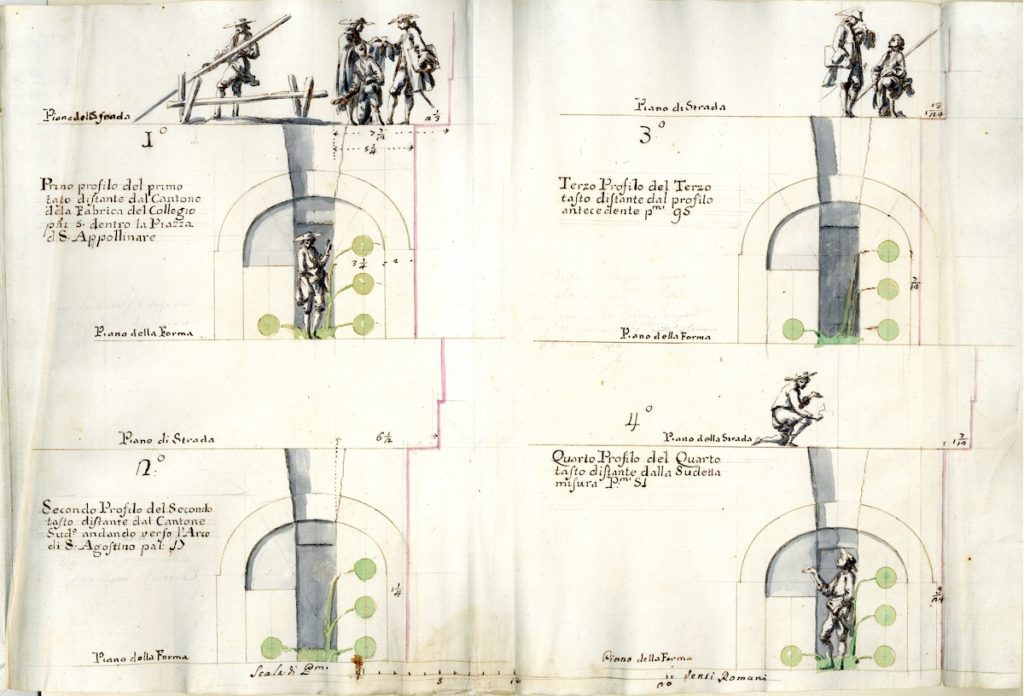
Sociable figures materialize in many of the survey drawings Marchionni executed in his capacity as a hydraulic expert. Their appearance is surprising in a professional domain that emphasized the transmission of practical information. Although figures often appeared in early modern treatises on engineering and machines, their purpose was to demonstrate the use of tools, scaffolding, or construction techniques.[28] They belonged to the mechanical sphere rather than to the world of sociability. In Marchionni’s graphic work, by contrast, whether his drawings for engineering projects or for domestic interiors, conversation is a social space, which is inhabited by all members of society from laborers to the leisured elite. Employed by the Sagra Congregazione delle Acque, Marchionni was called upon to participate in papal projects throughout Rome and Lazio. In 1750, for example, he was charged with assessing damage to the conduits of the Acqua Vergine, which was purportedly caused by a building expansion undertaken by the Jesuits at the Collegio Germanico in Rome.[29] Marchionni produced ten reports and eighteen drawings for the survey, which include both practical and painterly components and suggest a professional temperament that was little changed from his formative years. He offers a factual study in the form of a visually striking display, with measurements and notations typical of an architect’s survey combined with a vibrant green wash that renders the hydraulic problems unmistakable (Fig. 13). Figures measure, point, and confer with one another, enacting the process of evaluation.
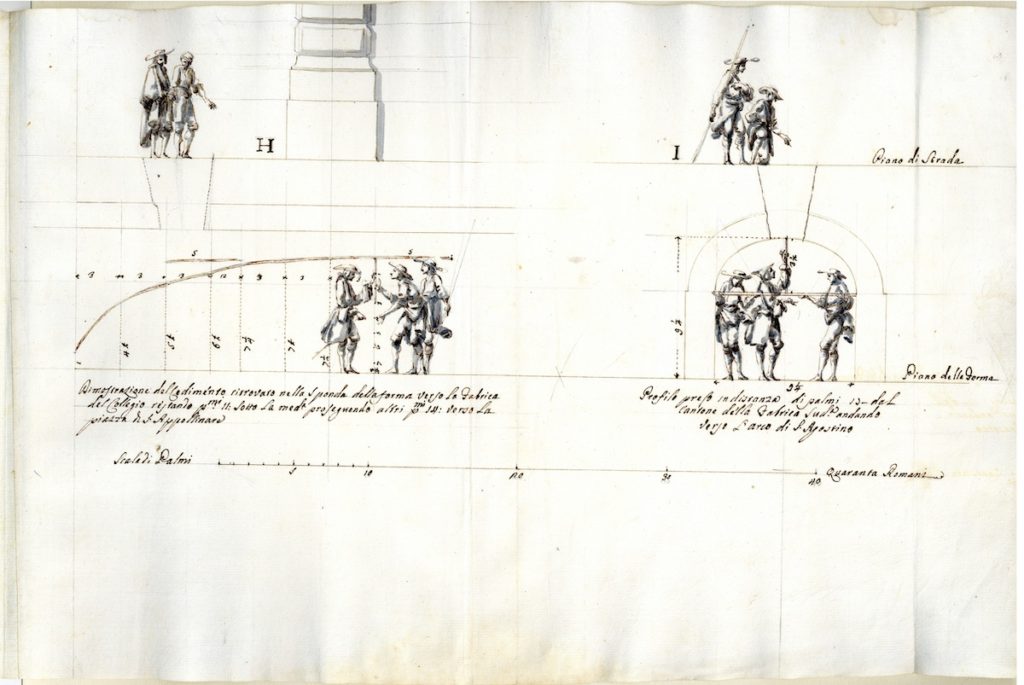
These figures are too impressive to be elements that Marchionni inserted merely for scale, and they are unorthodox for technical renderings. Figures appear nowhere in the work of other Italian hydraulic engineers such as Carlo Fontana, whose drawings were well represented in the collections of Cardinal Albani and therefore were readily accessible to Marchionni.[30] In the Acqua Vergine drawings, the figures hold the tools of their trade, such as the measuring rod or plumb line, and they are distinguished by their humble garb. A well-dressed Marchionni carries a book of drawings beneath one arm, an attribute that makes his professional position readily identifiable. Marchionni converses energetically with workers at the site and does not shrink from taking his own measurements. He shares in the labor of surveying that was, of necessity, a collaborative process (Fig. 14).[31] In these hydraulic renderings, measurement and assessment is an occasion for conversation, not only between professionals of equivalent stature, but also between the architect and the artisans, each of whom Marchionni names in the reports. They are not simply stock figures employed to demarcate distinctions in rank.[32] The drawings indicate how easily Marchionni moved in diverse circles, engaging equally in practical as in artistic discourse. Unlike other early modern images of labor and engineering, there is an intensity to the social interactions—as Marchionni bends over, either to listen or to instruct—which suggests the generative power of conversation (Fig. 15).
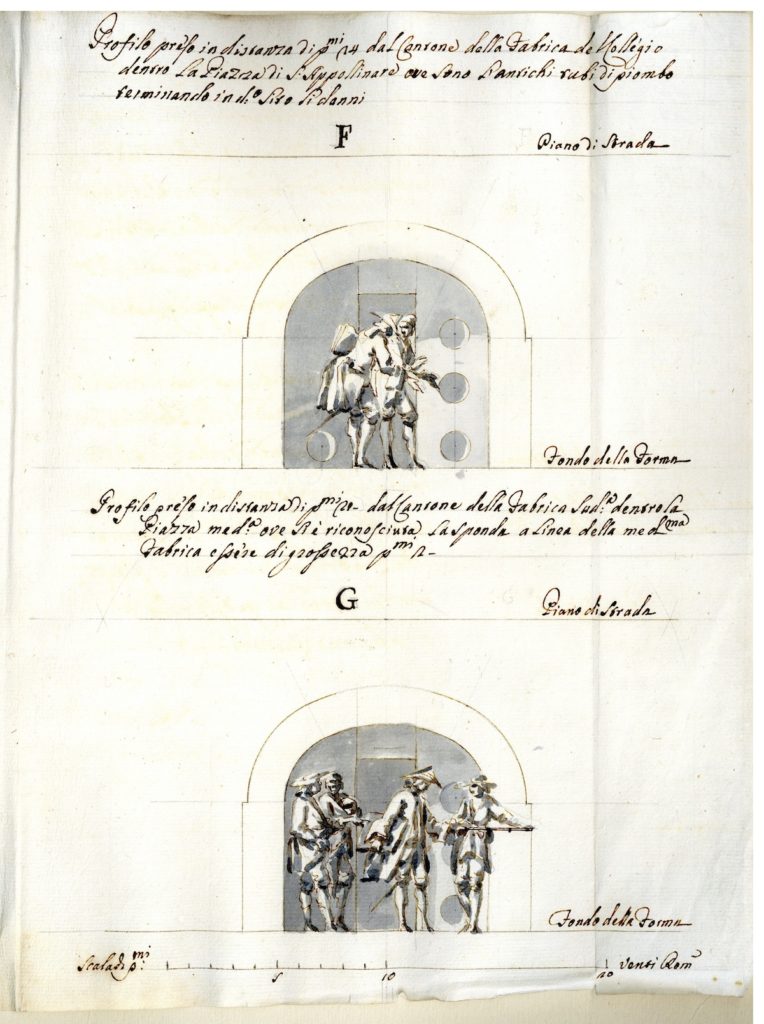
The idea that sociability is fundamental to the practice of architecture is implied by Marchionni in works of all kinds, including secular and ecclesiastical commissions, ephemeral and permanent structures, luxury and utilitarian projects (Figs. 1-4). In a set of interior elevations that Marchionni conceived in the mid-1750s for the gallery of Cardinal Albani’s suburban villa, a building that made his reputation as an architect in Rome, he displays his lifelong concern for social relationships and social spaces. Though other architects including Antoine Le Pautre (1621-1679) and Giuseppe Barberi (1746-1809) occasionally incorporated genteel figures into their elevation drawings, their work did not examine the world of early modern sociability so important to both Marchionni and Albani.[33] Marchionni’s success lay in part in his gift for exploring visual imagery and pictorial methods that satisfied his creative impulses and patronal demands equally well. In Marchionni’s renderings, the gallery is animated by figures in fashionable dress. They are outfitted with the trappings of gentility, including the cane, sword and three-sided hat of the eighteenth-century gentleman and the fan of the distinguished gentlewoman. Civility is inscribed in the body through fashionable dress and fine movements, and in the building through ornament (Figs. 1, 16). Worked up with exquisite attention in pen and wash, the figures and the ornament overshadow the graphite lines of the architecture and call into question the nature and function of the drawings. This series of drawings—highly finished, though unsigned—hover between the genre of presentation drawing (which, as an architect, Marchionni would be expected to offer his patron during the course of design development) and paintings and drawings known in the eighteenth century as “conversation pieces.” The latter feature interior spaces and convey social relations and meanings through furnishings and the dress, bodily comportment, and gestures of inhabitants.[34]
The drawings Marchionni produced for the Villa Albani belong to an international culture of civility in Grand Tour Europe—a shared language of bodily comportment, gesture, and fashion that circulated in printed texts and visual imagery. Treatises on civility, that is, the art of good manners, polite behavior, and courtesy, had been produced in Europe for centuries. Civility and corporeal eloquence informed the drawings and paintings of Marchionni’s contemporaries in Rome, among them Hubert Robert, Pompeo Batoni, and Giovanni Paolo Panini. Until Marchionni, the language of courtesy and sociability had never appeared in architectural elevations. Marchionni’s eloquent bodies speak volumes, and they were deliberately chosen, positioned, and dressed. His figures reveal their civility in a way that corresponds to techniques for the social control of the body prescribed by etiquette manuals, many of which he owned.[35] The conversational groupings that distinguish Marchionni’s drawings call to mind the refined milieu of the Roman court and point to a patron eager for social and cultural distinction. At the same time, much like Cardinal Albani, Marchionni was immersed in a world of collecting, learning, and civility.
Marchionni embedded a visual manual of comportment into renderings for the Albani gallery, underscoring not only the importance of conversation in civil society, but also its significance in the artistic sphere. The figures eloquently articulate an analogy between conversation and drawing, both of which are open-ended, generative, aesthetic forms whose creative intersection was critical to the production of culture in early modern Rome. Very telling are a handful of self-referential details that appear in versions of the north portal. These details suggest the ways in which the values and interests of a patron and an artist may have overlapped, but also where they diverged. In a drawing owned by the Cooper Hewitt, Marchionni depicts a pair of figures deep in discussion to the left of the threshold (Figs. 1 and 2). This conversational pair illustrates the integral part drawings played in the sociable practices of the elite. The two men are poring over what is most likely a design for the portal, the Albani eagle spreading its wings above a broken pediment. The figure who faces towards us points with his right index finger and is likely a depiction of the artist.[36] Marchionni envisions himself conversing with a person of genteel standing, in distinct contrast to the interactions portrayed in the hydraulic surveys. The intensity of conversation commands our attention and encourages viewers to imagine the flow of discourse. Marchionni’s vigorous directional pointing may also reference a space just out of sight. He points to the west, where in an adjacent room he was designing a mantelpiece with an eagle set into a broken pediment, much as he designed for the north gallery portal.[37]
Eighteenth-century conversation pieces often incorporated depictions of artists engaged in drawing, a type of self-referential imagery that has migrated here to a different genre.[38] Marchionni references his activity as a draftsman in a way that is specific to the internal conditions of the drawing, yet he offers no narrative resolution within the image (Fig. 1). He demonstrates the significant position drawing occupied in eighteenth-century aristocratic culture, a culture in which he found himself entrenched. In this period the art of drawing, including that of architectural drawing, was enjoying growing prestige. Drawings assumed a central position in the burgeoning study of the history of art and in the development of connoisseurship. They were treasured by collectors as aesthetic objects, which were worthy of display and learned conversation.[39] Harnessing this cultural cachet, Marchionni signals his confidence in his own social and professional standing; and, at the same time, he suggests the generative function that learned conversation played in his creative production.
Marchionni’s figures give voice to preoccupations distinctly his own even as they operate as elite signifiers well-suited to a noble benefactor. Marchionni makes clear in his work the foundational role drawing played in both craft and art, and he asserts the importance of drawing and sociability at all levels of the social and the artistic ladder. A set of three sheets, currently in the possession of the Istituto Centrale per la Grafica in Rome and once part of a single drawing, offers subtle but revealing variations in the figures and the composition Marchionni conceived for the north gallery portal of the Villa Albani (Figs. 1, 16). Elisabeth Kieven has linked the three fragments with a fourth drawing for an overdoor. Based on the extant architecture of the gallery portals, Kieven has convincingly argued that the entire composition represents a proposal for the east entrance (Fig. 16). Marchionni evidently enjoyed working through playful combinations of architectural and sculptural elements, offering his patron multiple alternatives for each portal. When we compare the Rome fragments to the Cooper Hewitt drawing, the position of the architect and his interlocutor are flipped, and the status of the conversational partner is downgraded (Figs. 2, 16). In the Rome version, Marchionni depicts himself in dialogue with an artisan, who is marked by his humble clothing and a relaxed posture as well as by the long measuring rod he holds in his right hand (Fig. 16). The open-handed gesture of the artisan compels our attention. Since antiquity this gesture had been associated in both texts and images with civility, liberality, and generosity. The open hand appeals, suggests, or invites.[40] At the same time, this modest hand motion draws viewers into and through the fictive spaces of the rendering. At the far left, Marchionni, elegantly dressed as always, has removed his tricorn hat, which he holds under one arm. This subtle act is a sign of respect. He opens a sheaf of drawings, he bends his knee, and he leans in intently to hear his partner’s words. At the top of the stack of drawings there appears a sketch of a triangular pediment, barely discernible, which confirms the link between the Rome fragments and the drawing for the overdoor of the east portal to which the sketch apparently refers.
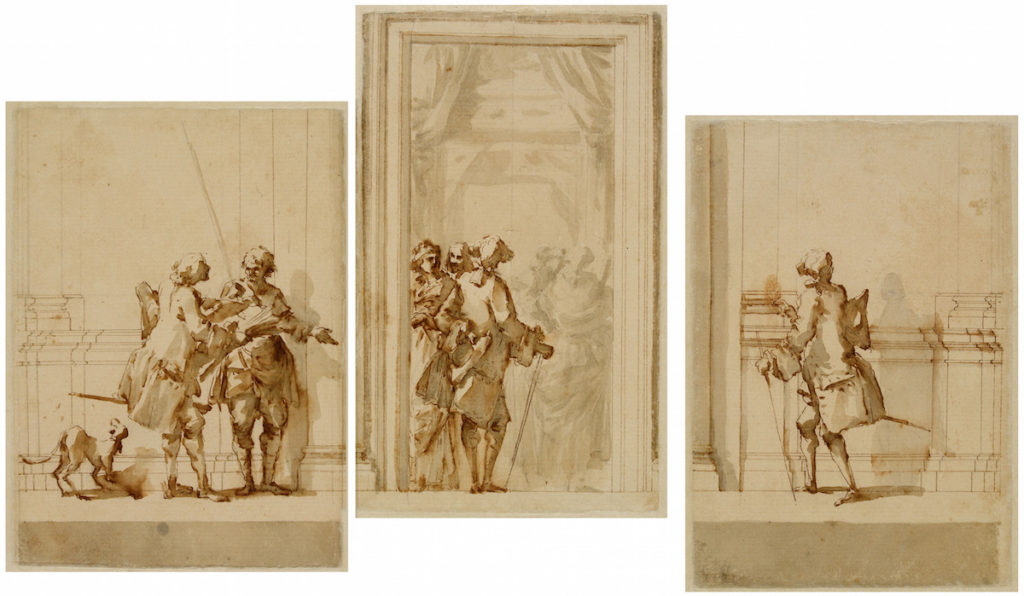
The dialogue exchanged by this conversational pair remains inaudible; however, given the gesture of civility that compels the attention of the audience, perhaps it is the artisan who leads the discussion (Fig. 16). Marchionni seems to defy Roman social mores by depicting an artisan in an aristocratic space, in close relation to his superior, the architect. Italian writers on etiquette from Giovanni Della Casa (1503-1556) to Stefano Guazzo (1530-1593), both widely read into the eighteenth century, argue that civility stands at the core of a happy, well-functioning society. Polite behavior is recommended for all members of the social order, whether they are humble or genteel. The word conversation referred to social relationships and it implied, but did not require, discourse.[41] Is Marchionni suggesting that an array of human interactions constitutes civil society? That the intellectual and creative benefits of conversation are best realized in a shared social space? Marchionni’s architectural renderings are themselves very likely to have been the products of collaboration, the graphite lines that indicate structural elements laid down by students, the figures then added by the artist. Like many busy architects in early modern times, Marchionni relied heavily on students in his workshop to produce drawings, including his son and heir Filippo (1732-1805). The mark of his artistry is felt most clearly in the quick strokes of ink and wash Marchionni used to flesh out the graphite elevations with evocative landscape elements, fantastical ornament, and figures.
Marchionni was mindful of the way creativity intertwined with conversation, whatever the circumstances of those who participated. His figured architectural drawings not only reflected contemporary practices of sociability but also actively encouraged, examined, and, even challenged them.[42] Many questions remain regarding the graphic variants Marchionni produced for the Albani gallery portals. Perhaps the set of three drawings at the Istituto Centrale per la Grafica, which were pulled apart at some point and separated from the collection of portal drawings at the Cooper Hewitt, is a permutation that Cardinal Albani rejected. The fragments seem to conform only partially to the type of imagery that an aristocratic patron such as Albani might wish to project, pointing us back to their author.
The creative confluence of conversation and drawing is linked with the materiality of the graphic work in a single instance in Marchionni’s oeuvre. In a project he conceived for a chapel most likely dedicated to the Magdalen,[43] Marchionni depicts himself in elegant attire. Around him gathers a conversational group with whom he is deeply engaged (Figs. 3 and 4). This architectural elevation reflects the academic tradition that produced it; nonetheless, it remains exceptional for its time. Marchionni makes use of color, trompe l’oeil, and figures to transform an ostensibly technical drawing into a pictorial tour de force. The conception of the altarpiece—with its image of the penitent Magdalen, a cross, a skull, and a book set in a mountainous landscape—points to a painterly hand at work. Tacked just below the lightly-colored elevation of the chapel is a ground plan. Represented as a working drawing, the plan for the chapel and its altarpiece is finely ruled, with the principal elements labeled in graphite. The edge of the fictive sheet curls to reveal a second, richly decorated layer and boldly intersects the space of the viewer. Marchionni intensifies the illusionism to underscore the materiality and instrumentality of the drawing, at once a physical object and an active, creative force. He includes not one but two internal drawings, picturing himself at the left with a small drawing for the altarpiece revealed in his hands. At his side, an artisan in humble garb bends on one knee and spreads his arms persuasively. Marchionni steps forward, he turns to listen, and he brings his full attention to his interlocutor. The measuring rod the artisan holds implies a discussion about utilitarian matters, but the drawing Marchionni unfurls highlights sculptural elements of the altarpiece, suggesting a multi-layered discourse. Whichever the case, conversational speech is open-ended. Conversation, like disegno, is a productive, experiential activity. It is a fluid, dynamic, aesthetic form, which represents the process of creation and, much as does drawing, requires the audience to participate. There is no text to support a fixed narrative that can be easily read, which gives free play to the imaginations of viewers and invites a variety of responses.[44]
Carlo Marchionni occupies a significant position in the history of early modern architectural draftsmanship in Italy. Throughout his career he encouraged his audience to appreciate architectural drawings as much more than surrogates for built structures. His consummate handling of materials, particularly his deft handling of watercolor and wash, underscored the architect’s unique position in shaping the spaces of sociability and artistic practice. In Marchionni’s drawings the productive actions of human figures, who engage with one another and with works of art, call social space into being. The performative role of the body and the materials of art occupy center stage. Marchionni situates drawings within drawings in many of his compositions, where they serve as graphic testimony of artistic performance and self-presentation. His renderings support and encourage the development of social customs and artistic practices and participate in the creation of culture. By depicting conversations that unfold around drawings, Marchionni illustrates the way architectural representation partakes in the most creative productions of human culture. Whether embodied in the materiality of the graphic work, or the corporeal shape of the architect performing on the page, Marchionni’s artistic identity resides in the agency of drawing.
Tracy Ehrlich is an architectural and landscape historian at Parsons
School of Design/The New School, New York, NY
Acknowledgements: My thanks to Caroline Dionne and Rosemary O’Neill for including me in the Parsons symposium, Unruly Design: Making Changing, and Breaking the Rules (March 2018), where I first explored many of the ideas presented in this article. My gratitude to Jeffrey Lieber for his incisive comments on earlier drafts, and to Melissa Hyde, Hannah Williams, and Meredith Martin for their enthusiasm for my subject. I thank my anonymous readers for their necessary reminders.
[1] Dizionario biografico degli italiani (Rome: Instituto della Enciclopedia Italiana, 2007), 69, s.v. “Carlo Marchionni.” The Congregation of the Fabbrica is the church body responsible for maintaining the basilica of St. Peter’s. See n. 3 below for the fundamental literature on Marchionni.
[2] Marchionni was trained in the art of engraving, but few prints from his hand are known. In 1733 he engraved a handful of drawings by his teacher Filippo Barigioni for the funeral of Augustus II of Poland at S. Clemente in Rome. Simonetta Ceccarelli and Elisa Debenedetti, eds., Rossiano 619: Caricature. Carlo Marchionni e Filippo (Vatican City: Biblioteca Apostolica Vaticana, 2016), 35. Debenedetti mentions two prints by Marchionni after Barigioni’s drawings, though the extant prints include only one clearly engraved by Marchionni. These are held in the Lanciani collection at the Biblioteca di Archeologia e Storia dell’Arte, Palazzo Venezia, Rome (30759 and Roma XI.38.VII.3; 30768 and Roma XI.38.VII.12). They may be viewed through the Rodolfo Lanciani Digital Archive at Stanford, https://exhibits.stanford.edu/lanciani/browse/roma-xi-38-chiese (accessed September 24, 2019).
[3] The Marchionni drawing corpus is spread among many collections, among them Cooper Hewitt, Smithsonian Design Museum, New York; Martin von Wagner Museum der Universität Würzburg, Würzburg; Musée du Louvre, Paris; Archivio di Stato, Rome; Museo di Roma, Rome; Accademia Nazionale di San Luca, Rome; Ashmolean Museum, Oxford. For the seminal work on Marchionni, see Rudolf Berliner, “Zeichnungen von Carlo und Filippo Marchionni. Ein Beitrag zur Kunst- und Kulturgeschichte Roms im 18. Jahrhundert,” Münchner Jahrbuch der bildenden Kunst series 3, no. 9/10 (1958-1959), 267-396. Of Elisabeth Kieven’s many publications on Marchionni, see, for example, “Kreative Phantasie: Carlo Marchionni (1702-1786) als Zeichner,” in Architektur und Figur: Das Zusammenspiel der Künste; Festschrift für Stefan Kummer zum 60. Geburtstag, eds. Nicole Riegel and Damian Dombrowski (Munich: Deutscher Kunstverlag, 2007), 454-463.
[4] James S. Ackerman, “On the Origins of Art History and Criticism,” in Origins, Imitation, Conventions. Representation in the Visual Arts (Cambridge, MA: The MIT Press, 2002), 16. On drawing and the profession of architecture, see Giovanna Curcio, “La città degli architetti,” in In Urbe Architectus: modelli, disegni, misure; la professione dell’architetto Roma 1680-1750, eds. Bruno Contardi and Giovanna Curcio (Rome: Argos, 1991), 144-146; Daniel Rabreau, Les dessins d’architecture au xviiie siècle (Paris: Bibliothèque de l’Image, 2001), 16.
[5] Ann C. Huppert, Becoming an Architect in Renaissance Italy: Art, Science, and the Career of Baldassare Peruzzi (New Haven: Yale University Press, 2015), 1, 45, 166; David Rosand, Drawing Acts. Studies in Graphic Expression and Representation (Cambridge and New York: Cambridge University Press, 2002), 58.
[6] Marchionni was elected member of the Academy of St. Luke in 1740. See Dizionario biografico degli italiani, 69, s.v. “Carlo Marchionni.”
[7] Huppert, Architect, 125-126. The architect Giuseppe Barberi (1746-1809) includes a figure in one drawing for a portal, but this figure lacks the social indicators that distinguish Marchionni’s elevation drawings. See Cooper Hewitt, Smithsonian Design Museum, New York, 1938-88-1192. Elisabeth Kieven notes the important role Carlo Fontana played in the development of the architectural “view” as a form of presentation drawing, into which he often incorporated figures and other small narrative or landscape elements typical of engravings. Kieven, “Il disegno di architettura a Roma,” in Giuseppe Piermarini: tra barocco e neoclassico; Roma, Napoli, Caserta, Foligno, eds. Marcello Fagiolo and Marisa Tabarrini (Perugia: Effe, 2010), 116-118. Fontana did not, however, include figures in elevation drawings except for scale.
[8] See for example, Stefano Della Bella’s 1656 etching of a young boy drawing the Medici Vase in the gardens of the Villa Medici, Rome. Della Bella served as drawing master to Cosimo III de Medici, Grand Duke of Tuscany. The print comes from a series titled Six grandes vues […] quatre de Rome et deux de la Campagne romaine (New York Public Library, New York, Wallach Division, Print Collection). From Marchionni’s time, see, among many other examples, Hubert Robert, The Draughtsman of the Borghese Vase, c. 1775 (Musée des Beaux Arts, Valence).
[9] For the distinction between ink washes and watercolors, see Caroline Corrigan, “Drawing Techniques,” in Old Master Prints and Drawings: A Guide to Preservation and Conservation, eds. Caroline Corrigan, Carlo James, Marie Christine Enshaian, and Marie Rose Greca (Amsterdam: Amsterdam University Press, 1997), 75-80; Rabreau, Les dessins, 16. On Marchionni’s use of ink washes and watercolors, see Barbara Tetti, “The Space Between the Banks of the Tevere River: Carlo Marchionni’s Drawings of Three Roman Bridges,” in Agents of Space: Eighteenth-Century Art, Architecture, and Visual Culture, ed. Christina Smylitopoulos (Newcastle-upon-Tyne: Cambridge Scholars Publishing, 2016), 61-77.
[10] John Pinto, “Architecture and Urbanism,” in Art in Rome in the Eighteenth Century, eds. Edgar Peters Bowron and Joseph J. Rishel (Philadelphia: Philadelphia Museum of Art, 2000), 131; Kieven, “Il disegno di architettura a Roma,” 118-22. Other eighteenth-century architects who experimented with illusionistic layering of the surface include Bernardo Antonio Vittone (1704-1770), Giovanni Battista Borra (1713-1770), and, most famously, Giovanni Battista Piranesi (1720-1778). The relationship between the graphic work of Marchionni and Piranesi, whose paths crossed on multiple Roman building sites, is the subject of a forthcoming publication by this author. Marchionni’s work was probably an important model for Piranesi. See Elisabeth Kieven, “Roman Architecture in the Time of Piranesi, 1740-1776,” in Exploring Rome: Piranesi and his Contemporaries, eds. Cara Denison, Myra Nan Rosenfeld, and Stephanie Wiles (New York: The Pierpont Morgan Library, 1993), xxii.
[11] Kieven, “Il disegno di architettura a Roma,” 118-22. As a young artist training in Rome, Marchionni would have had access to the drawings of Juvarra and Fontana, among others, as a participant in the Concorsi Clementini and later as a member of the Academy of St. Luke. When he came under the protection of Cardinal Albani, this position ensured privileged access to the family collection, which included the drawings of Carlo Fontana purchased by Clement XI Albani in 1716, inherited by Cardinal Albani in 1721, and sold in 1762 (see n. 30 below). See Simonetta Prosperi Valenti Rodinò, “I disegni di Casa Albani,” in Alessandro Albani patrono delle arti, ed. Elisa Debenedetti (Rome: Università degli Studi La Sapienza, Istituto di Storia dell’Arte Medievale e Moderna), 22-29.
[12] Kieven refers to Marchionni as the most prolific and inventive draftsman in eighteenth-century Rome after the death of Juvarra (“Il disegno di architettura a Roma,” 122).
[13] For the most part, as Basile Baudez has noted in discussing the introduction of color to French architectural drawings, color was employed in design projects as an abstract rather than representational language. Italian architects favored monochrome drawings until the eighteenth century, at which time draftsmen introduced color but not in a codified, systematic way. Marchionni uses blues and greens for representational purposes in areas of water or sky, but he also employs color in dramatic, often unconventional ways. Basile Baudez, “Inessential Colors: A History of Color in Architectural Drawings 16th through 19th Centuries,” lecture given at the Bard Graduate Center, New York, 3 October 2017, https://www.bgc.bard.edu/events/542/03-oct-2017-inessential-colors (accessed September 24, 2019). See also Edward Tufte, Envisioning Information (Cheshire, CT: Graphics Press, 1990), 81-83.
[14] Elisabeth Kieven, “Il disegno architettonico come mezzo di comunicazione tra committente e architetto,” in In Urbe Architectus, 76-77; Allan Braham and Hellmut Hager, Carlo Fontana: The Drawings at Windsor Castle (London: Zwemmer, 1977), 21. See also n. 13 above.
[15] On architectural drawings as aesthetic objects in the eighteenth century, see Rabreau, Les dessins, 10-12; Tetti, “Space,” 61, 70, 75-76. Tetti stresses Marchionni’s use of color to enhance the pictorial component of technical illustrations.
[16] Rosand, Drawing Acts, xxiii: “As a direct record of motions of the body, a drawing inevitably takes us back to the drawing hand, to the body of the draftsman, in a kinesthetic circuit.”
[17] Gail Feigenbaum, “Introduction: Art and Display in Principle and in Practice,” in Display of Art in the Roman Palace 1550-1750, eds. Gail Feigenbaum and Francesco Freddolini (Los Angeles: Getty Research Institute, 2014), 11. David Rosand underscores the way drawing reflects the physical gestures and bodily movement of the artist, noting that viewer response therefore “necessarily [has] a somatic dimension,” Drawing Acts, 16.
[18] For Marchionni’s festival designs, including catafalques, see the collections in Würzburg and at the Cooper Hewitt museum (n. 3 above). For Marchionni’s landscape drawings, see the collections at the Louvre and the Cooper Hewitt. Bénédicte Ledru, “Carlo Marchionni (1702-1786): deux albums de dessins acquis par le Départment des Arts Graphiques du Louvre,” in Revue du Louvre 43:3 (1993), 28-40. Barbara Tetti has linked Marchionni’s pictorial approach to architectural vedute with the practices of such view painters as Giovanni Paolo Panini, whose work he owned. See Tetti, “Space,” 63-64. On Marchionni’s art collection, see Francesco Petrucci, “Pittura barocca romana: la collezione Marchionni,” in Studi sul Settecento III (Turin: Allemandi, 2003), 79-88.
[19] The internal evidence of Marchionni’s drawings made for the 1728 competition suggest that architectural drawings were hung on the wall, even if temporarily, for display and discussion. Cf. Hubert Robert’s red chalk drawing of artists at work in a studio, The Metropolitan Museum of Art, New York, 1972.118.231. A detailed description of the studio of Mattia de Rossi (1637-1695), a student of Bernini who later directed the Fabbrica of St. Peter’s, offers insight into contemporary practices of display among architects. In addition to a collection of paintings and sculptures, De Rossi owned a large array of architectural drawings that were either framed and hung on the wall, or were placed on tables, some in protective glass. The studio was both a place for students to learn and a place to impress patrons with the dignity of the architectural profession. See Curcio, “La città degli architetti,” 147-148.
[20]Petrucci, “Pittura,” 88. See also n. 19 above.
[21]For an enlightening discussion of materiality, see Michael Yonan, “The Suppression of Materiality in Anglo-American Writing,” in The Challenge of the Object: Proceedings of the 33rd Congress of the International Committee of the History of Art, eds. G. Ulrich Grossman and Petra Krutisch (Nuremburg: Almuth Klein, 2013), 1: 63-66; Bill Brown, “Thing Theory,” Critical Inquiry 28:1 (2001), 1-22; Alfred Gell, Art and Agency. An Anthropological Theory (Oxford: Clarendon Press, 1998), 6, 17-18, 22.
[22] I thank John Pinto for reminding me of the work of Edward Tufte, Envisioning Information, and The Visual Display of Quantitative Information (Cheshire, CT: Graphics Press, 2001).
[23] Huppert, Architect, 45, 166; Gell, Art and Agency, 23.
[24] For the rise of architectural drawing to the status of collectible akin to painting or sculpture, see for example, Curcio, “La città degli architetti,” 147-48. On architectural drawings, Marchionni’s in particular, as works of art, see Kieven, “Il disegno di architettura a Roma,” 122; Rabreau, Les dessins, 13-14; Tetti, “Space,” 61-65.
[25] On Marchionni’s use of illusionistic superimposition, see, Tetti, “Space,” 73. John Pinto writes that in his prints Giovanni Battista Piranesi pushed “a graphic stratigraphy of illusionistically layered multiple images to its very limits.” Pinto, Speaking Ruins: Piranesi, Architects, and Antiquity in Eighteenth-Century Rome (Ann Arbor: The University of Michigan Press, 2012), 163. The illusionistic, layered drawings completed by Marchionni for the 1735 survey recall some of the techniques employed by his teacher Filippo Barigioni in designs for the funeral of Augustus II of Poland, staged at S. Clemente, Rome in 1733. Marchionni engraved at least one (and perhaps two) drawings for the church decorations by Barigioni, the only work he undertook in printmaking. See n. 2 above.
[26] Mary Vidal, Watteau’s Painted Conversations: Art, Literature, and Talk in Seventeenth- and Eighteenth-Century France (New Haven: Yale University Press, 1992), 19, 130.
[27] I have found no other examples of early modern elevation drawings incorporating sociable figures. When figures do appear, they are typically employed for scale and lack the social attributes and sociability that distinguish Marchionni’s. In 1978 Robin Evans observed that “if anything is described by an architectural plan, it is the nature of human relationships […]. But what is generally absent in even the most elaborately illustrated building is the way human figures will occupy it. This may be for good reasons, but when figures do appear in architectural drawings they tend not to be substantial creatures but emblems, mere signs of life…” See Evans, Translations from Drawing to Building (Cambridge, MA: MIT Press, 1978), 56. See also n. 33 below on Antoine Le Pautre.
[28] See, for example, Carlo Fontana’s print showing the moving of the obelisk at St. Peter’s, undertaken by his ancestor Domenico Fontana in 1586. For the full set of engineering images see Carlo Fontana, Templum Vaticanum et ipsius origo (Rome: Buagni, 1694). Other contemporary treatises include Niccola Zabaglia, Castelli e ponti (Rome: Pagliarini, 1743). This type of image appears also in drawings, for example, “Workmen Building Arcades,” Cooper Hewitt Museum, New York, 1938-88-52, which is an anonymous pen and wash drawing c. 1740.
[29] Simonetta Ceccarelli, “Carlo Marchionni ‘Ingegnere della Sagra Congregazione dell’Acque’,” Studi sul Settecento Romano 24 (2008), 31-43.
[30] A large cache of Fontana’s hydraulic drawings, once owned by Cardinal Alessandro Albani, and now part of the King George III Topographical Collection at the British Library, London includes no figures comparable to Marchionni’s. See, for example, Fontana’s rendering of the conduits at the Belvedere Court at the Vatican (Cartographic Items Maps 7.Tab.57.10). Albani’s drawing collection was sold in 1762 to King George III, but up to that point would have been available to Marchionni as the cardinal’s house architect. See also Carlo Fontana, Utilissimo trattato dell’acque correnti (Rome: Buagni, 1696), a treatise that includes no figures in the illustrations. At the time of his death, Marchionni owned both Fontana’s 1696 hydraulic treatise and his 1694 treatise on St. Peter’s. For the inventory of Marchionni’s books, see Archivio di Stato, Rome, Trenta notai capitolini, Uff.19, Notaio C. Palombini, b. 693. For foundational work on Roman hydraulic engineers, see Simonetta Ceccarelli, “Gli Ingegneri dell’Acqua Paola. Disegni e documenti inediti di Carlo Fontana e di Carlo Marchionni,” in Storia dell’Arte 120 (2008), 117-144. I thank Katherine Rinne for her thoughts on the unique nature of Marchionni’s hydraulic surveys.
[31] Carolyn Yerkes, Drawing after Architecture: Renaissance Architectural Drawings and their Reception (Venice: Marsilio, 2017), 11. See Tetti (“Space,” 71) on Marchionni’s appearance in drawings for engineering work at Lake Bracciano.
[32] Dianne Harris, The Nature of Authority: Villa Culture, Landscape, and Representation in Eighteenth-Century Lombardy (University Park, PA: Pennsylvania State University Press, 2003), 89.
[33] My thanks to Meredith Martin for bringing to my attention the Le Pautre drawing at the Metropolitan Museum of Art, New York. Le Pautre’s figures demonstrate corporeal civility but they are not engaged in sociable discourse. For Giuseppe Barberi, see this drawing in the Cooper Hewitt collection.
[34] Kate Retford, “From the Interior to Interiority: The Conversation Piece in Georgian England,” Journal of Design History 20:4 (2007), 291-298, 303; and The Conversation Piece: Making Modern Art inEighteenth-Century Britain (New Haven: Yale University Press, 2017).
[35] The inventory of Marchionni’s art collection, made at his death, is well known. However, in publishing the inventory Petrucci (“Pittura”) omitted Marchionni’s books, which are the subject of a forthcoming article by this author.
[36] On Marchionni’s possible self-portrait, see Berliner, “Zeichnungen,” 308; Kieven, “Kreative Phantasie,” 460.
[37] This mantelpiece may be seen in a pen sketch from a private collection, known from Sotheby’s 27 January 2010 sale. Simonetta Prosperi Valenti Rodinò, Carlo Marchionni caricaturista tra Roma, Montefranco, Civitavecchia e Ancona (Rome: Campisano, 2015), fig. 40.
[38] Retford, Conversation Piece, 87-91.
[39] Genevieve Warwick, The Arts of Collecting: Padre Sebastiano Resta and the Market for Drawings in Early Modern Europe (Cambridge: Cambridge University Press, 2000), 78, 85; Kieven, “Kreative Phantasie,” 457, 461; Tetti, “Space,” 76.
[40] Giovanni Bonifacio, L’arte de cenni (Vicenza: Francesco Grossi, 1616), 309; John Bulwer, Chirologia: Or the Naturall Language of the Hand (London: Thomas Harper, 1644), 43-44, 62-65.
[41] Peter Burke, The Art of Conversation (Ithaca: Cornell University Press, 1993), 98.
[42] Gell, Art and Agency, 23.
[43] This project has not been dated, nor has it been linked to a specific location or patron. The identification of the chapel is not secure. However, based on the sketch for the altarpiece, it seems likely to be a chapel dedicated to the Magdalen.
[44] Vidal, Painted Conversations, 8, 43, 99; Rosand, Drawing Acts, 1, 3.
Cite this article as: Tracy Ehrlich, “Carlo Marchionni Architetto Romano: Drawing the Self in Eighteenth-Century Rome,” Journal18 Issue 8 Self/Portrait (Fall 2019), https://www.journal18.org/4255.
License: CC BY-NC
Journal18 is published under a Creative Commons CC BY-NC International 4.0 license. Use of any content published in Journal18 must be for non-commercial purposes and appropriate credit must be given to the author of the content. Details for appropriate citation appear above.

